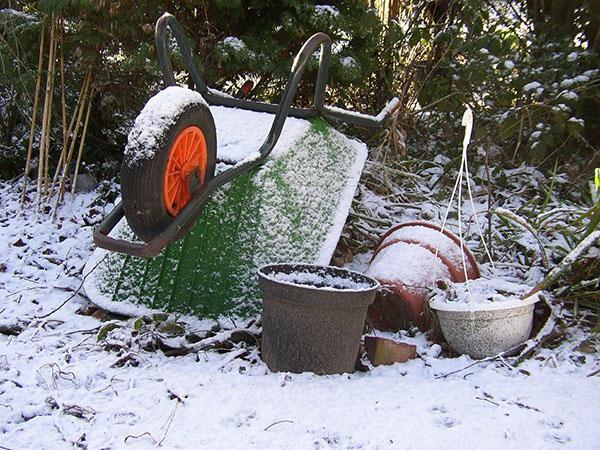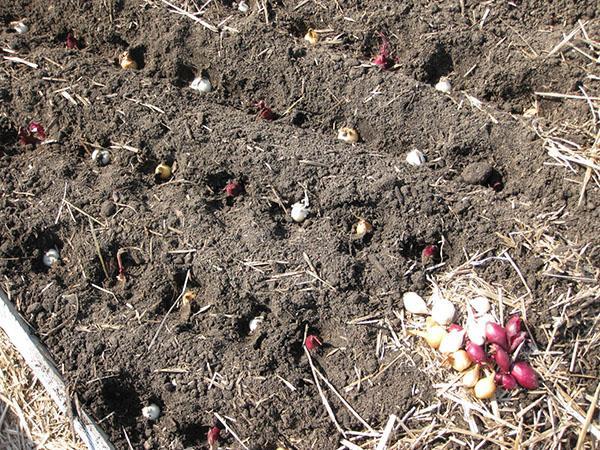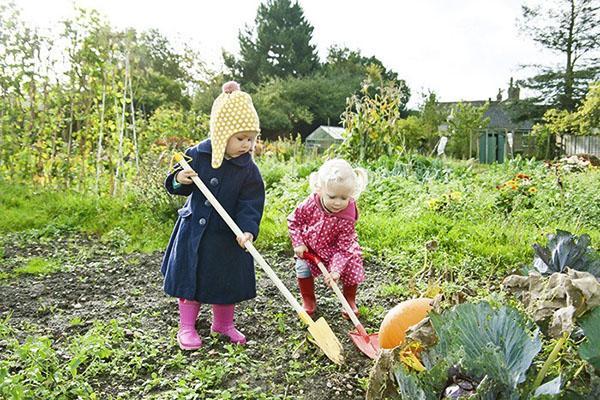Summer resident's calendar for November: work on garden beds
 In November, when the harvest is harvested, the summer resident, it would seem, could think about rest. But empty beds, summer cottages and harvested vegetables require attention. In the summer resident's calendar for November there are still a lot of important things that cannot be postponed on the eve of winter.
In November, when the harvest is harvested, the summer resident, it would seem, could think about rest. But empty beds, summer cottages and harvested vegetables require attention. In the summer resident's calendar for November there are still a lot of important things that cannot be postponed on the eve of winter.
Pre-winter sowing of greens, onions and root crops

- the earth is carefully dug up in advance;
- humus, potash and phosphate fertilizers;
- the soil is leveled and grooves are marked.
Seeds embedded in the ground are additionally mulched with a layer of humus, peat or rotted compost.
In early November, before the soil freezes, you can plant small onion sets. Bulbs up to 2 cm in diameter are buried by 4–5 cm. A gap of 15–20 cm is left between the rows and individual onions. After planting, the ridges are densely sprinkled with humus or peat.
November work on garden beds
 Late cabbage the very last to leave the country garden. They are less afraid of small frosts than other vegetables, but a serious decrease in temperature threatens damage to the surface leaves. Such cabbage is worse stored, so in early November it is cut down, leaving only a couple of centimeters of stumps under the head. Leaves, dried up, rotten and damaged by insects, are pruned, together with the remains of stems and roots, destroyed.
Late cabbage the very last to leave the country garden. They are less afraid of small frosts than other vegetables, but a serious decrease in temperature threatens damage to the surface leaves. Such cabbage is worse stored, so in early November it is cut down, leaving only a couple of centimeters of stumps under the head. Leaves, dried up, rotten and damaged by insects, are pruned, together with the remains of stems and roots, destroyed.
 Vegetable garden freed from harvest before winter:
Vegetable garden freed from harvest before winter:
- cleaned of plant residues, which are either sent to compost, or burned, obtaining valuable ash;
- dug on a full bayonet with a shovel.
If grass paths are laid on the site, it is better to "put them under a shovel" too. Such a measure will help get rid of weeds, which happily take root and reproduce in untouched places.
It is convenient to add dolomite flour for the autumn digging. In this case, you do not need to break the clods. With the onset of frost, most of the harmful insects and fungi caught in them and close to the soil surface will die.
November: greenhouses and greenhouses in the spotlight
 In November, the care of the summer resident requires not only the beds, but also the greenhouses left over from the summer, film and stationary greenhouses.
In November, the care of the summer resident requires not only the beds, but also the greenhouses left over from the summer, film and stationary greenhouses.
The soil inside the greenhouses is freed from tops, fallen fruits of tomatoes, cucumbers and other crops. Plant residues are taken out and destroyed. Digging the beds. The film and collapsible structures are washed, dried and put away for storage.
Stationary greenhouses are washed from the inside with a disinfectant solution, the wooden parts of the frame are treated with fungicides. If necessary, repairs are carried out, cracks are closed, doors and transoms are strengthened. Since the crop rotation in such facilities is organic, deep digging is not enough here. It is advisable to remove the top layer of soil by 5 cm and notice it with a fresh substrate enriched with humus, rotted compost, a mixture of peat with fertilizers.It is useful to shed indoor beds with a solution of phytosporin or another preparation for soil reclamation.
When greenhouses are ready for the new season, onions, as well as parsley, celery and other herbs that have been in the open ground for the time being, can be planted in them to get fresh greens.
From the beds to storage: we save the grown
 Storehouses for vegetables and root crops are prepared for harvest in the summer. They are strengthened, in every possible way protecting from the penetration of rodents. However, sometimes mice enter basements not only through underground passages, but also through ventilation, in bags with vegetables. If on potatoes, carrots, beets have teeth marks, rodent droppings are visible on the shelves, you need to immediately take measures:
Storehouses for vegetables and root crops are prepared for harvest in the summer. They are strengthened, in every possible way protecting from the penetration of rodents. However, sometimes mice enter basements not only through underground passages, but also through ventilation, in bags with vegetables. If on potatoes, carrots, beets have teeth marks, rodent droppings are visible on the shelves, you need to immediately take measures:
- identify and seal the moves;
- set up traps;
- decompose poisoned baits in places safe for humans;
- sort out vegetables and remove those that are already damaged by pests.
By November, most of the harvest has already been laid in storage. Summer planting potatoes are lowered into the cellars last, cabbage heads are sent. Full bins are pleasing, but they should not be left unattended. Regularly, starting from the second half of November, vegetables are examined, sorted out and, revealing spoiled, removed. If this is not done, rot will quickly spread, depriving the summer resident of a significant part of the grown.
Caring for the next harvest
 To prolong the ripening process and protect it from leaching, the compost is covered with foil or other moisture-resistant materials before the onset of rains and frosts.
To prolong the ripening process and protect it from leaching, the compost is covered with foil or other moisture-resistant materials before the onset of rains and frosts.
Due to insemination by harmful fungi, the tops of potatoes, tomatoes, cucumbers, zucchini and pumpkins, cabbage stumps and a lot of other plant residues are not suitable for composting. It is better to burn it, like the branches left after cutting garden trees and shrubs. The resulting ash is either applied to the ground or stored until spring to be used as a valuable potash-phosphorus fertilizer in the next season.
It is important to clean, rinse and dry the garden equipment after completing work in the garden. Shovels, saws, axes and hoes and other tools harbor. Garden equipment is removed for storage.
Completing this summer season, do not forget about the following. Before the onset of frost, soil is prepared for future seedlings. The filled bags can be stored in any convenient place, for example, on a balcony or in the basement of a city house, in a garage or in a country house.